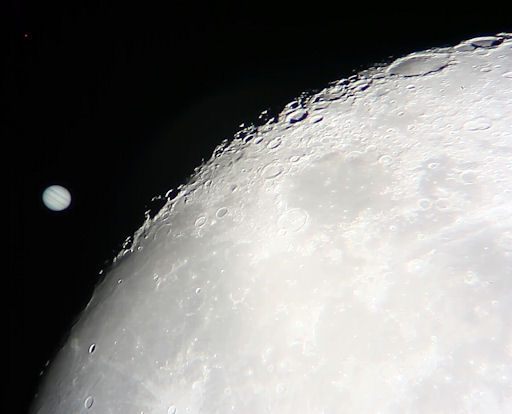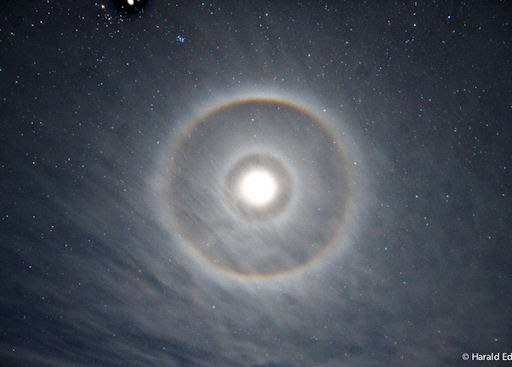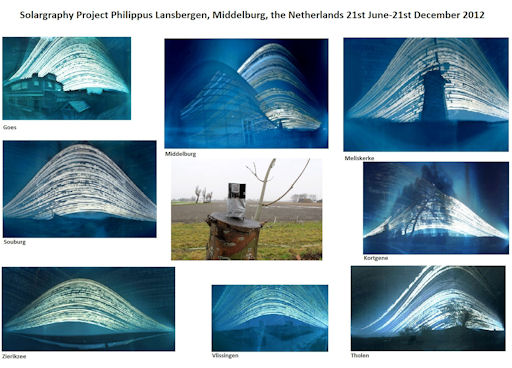SLIM CHANCE OF FLARES: Sunspot AR1635 is crackling with low-level C-class solar flares. There is a slim chance of stronger flares: NOAA forecasters put the odds of an M-class eruption on Dec. 26th at 5%. Overall, solar activity is very low and is likely to remain so for the rest of the week. Solar flare alerts: text, voice.
CHRISTMAS COVER-UP: When the sun went down on Christmas, a pair of bright lights rose in the east; Jupiter and the Moon were having a holiday conjunction. In Brazil, the pair were so close, the Moon completely covered Jupiter. Marcelo Domingues of Brasilia snapped this picture seconds before the occultation:
"It was a beautiful event," he says.
"What a perfect Christmas gift this was!" adds Gustavo Rojas of São Carlos. "I managed to capture the giant planet just as he started to disappear behind the lunar disk."
In case you missed it, there will be more lunar occultations of Jupiter in 2013. A complete list is available from the International Occultation Timing Association.
Realtime Jupiter Photo Gallery
ODD-RADIUS MOON HALOS: Many sky watchers have witnessed a halo around the moon--a ring of light that surrounds the lunar disk at a radius of 22 degrees. The phenomenon is caused by pencil-shaped ice crystals in cirrus clouds that bend moonlight. On Dec. 21st, Harald Edens of Magdalena, New Mexico, witnessed a rare double halo:
"Just after 7 PM local time I noticed a bright 22-degree halo around the moon," says Edens. "It was only when I started photographing that halo when I discovered a rare 9-degree halo inside the 22-degree halo."
The inner 9-degree halo is caused by ice crystals in the shape of pyramids. "Apart from the 9-degree circular halo, an 18-degree and perhaps a 35-degree circular halo were also present at times," he adds. All of these "odd-radius" halos are caused by icy pyramids.
The display quickly became even more varied. Edens saw at least a dozen different kinds of luminous rings and arcs, enumerated in his complete description of the event. "The display was highly transient," he notes. "Not only did the cirrus move fairly swiftly in the sky, but the halos - especially the odd-radius halos - appeared to come and go over the course of just a few minutes." But what a few minutes it was!
Realtime Space Weather Photo Gallery
SUNLIGHT IN A BEER CAN: Last June, astronomers at Philippus Lansbergen Observatory invited members of the public to build their own solargraphs and record the motion of the sun across the sky. "On Dec. 21st, we received more than 50 solargraphs from people all over the Netherlands who collected sunlight in an empty beercan during the last 6 months," reports Jan Koeman. "Here are some results."
A solargraph is a pinhole camera made from a soda or beer can lined with a piece of photographic paper. Using this simple device, the citizen scientists of the Netherlands recorded the daily track of the sun beginning on June 21st, the northern summer solstice, and ending two seasons later on Dec. 21st, the northern winter solstice. High tracks correspond to early summer, low tracks to late autumn. The only gaps are due to clouds and rain. The Netherlands have a reputation for rainy weather, but these solargraphs show the sun was out more often than not.
With winter beginning in the northern hemisphere (and summer in the south), now is the time for a new batch of solargraphs to be deployed. Readers are encouraged to follow directions in the links below.
6-month Solargraph How-to Guides: #1, #2, #3

![]()
Solar wind
speed: 303.0 km/sec
density: 1.5 protons/cm3
explanation | more data
Updated: Today at 0017 UT
![]()
X-ray Solar Flares
6-hr max: C1 2048 UT Dec26
24-hr: C3 0455 UT Dec26
explanation | more data
Updated: Today at: 2359 UT
![]()
![]()
![]()
Daily Sun: 26 Dec 12
![]()
![]()
Sunspot 1635 is crackling with low-level C-class solar flares. Credit: SDO/HMI
![]()
![]()
![]()
Sunspot number: 58
What is the sunspot number?
Updated 26 Dec 2012
Spotless Days
Current Stretch: 0 days
2012 total: 0 days (0%)
2011 total: 2 days (<1%)
2010 total: 51 days (14%)
2009 total: 260 days (71%)
Since 2004: 821 days
Typical Solar Min: 486 days
Update 26 Dec 2012
The Radio Sun
10.7 cm flux: 113 sfu
explanation | more data
Updated 26 Dec 2012
![]()
![]()
![]()
Current Auroral Oval:
![]()
Switch to: Europe, USA, New Zealand, Antarctica
Credit: NOAA/POES
![]()
![]()
![]()
Planetary K-index
Now: Kp= 0 quiet
24-hr max: Kp= 2 quiet
explanation | more data
![]()
Interplanetary Mag. Field
Btotal: 3.2 nT
Bz: 2.3 nT north
explanation | more data
Updated: Today at 0017 UT
![]()
![]()
![]()
Coronal Holes: 26 Dec 12
![]()
![]()
Solar wind flowing from this coronal hole should reach Earth on Dec. 28. Credit: SDO/AIA.








Comments
Spacve Weather Update...
Anyone else notice how BRIGHT the Moon ws tonight? I was driving home from work while the Moon was rising and geez, it seemed the brightist I have ever seen it. Is this due to increased radiations (of some sort) from the Sun? Just a thought...
LOVE and Light...Cindyloucbp
Moon and Clouds oddity
Actually, in the wee morning hours of Dec 26, 2012, the moon was big and bright, and was partnered with the Orion constellation to its immediate left. A few fluffy clouds were approaching from the right moving left toward the moon, so I stood and watched as the clouds were about to pass in front of the moon. Except THE CLOUDS PASSED BEHIND THE MOON!
I blinked hard, trying to process what I just witnessed. Another puff of clouds were approaching from right to left again, so this time I watched with intention, hoping to disprove what I just saw. But this group of clouds passed BEHIND the moon as well. I am not fooling around here. That is what I saw. And no, I wasn't hallucinating or under any type of influence. That is what I saw. I do not have an explanation for it.